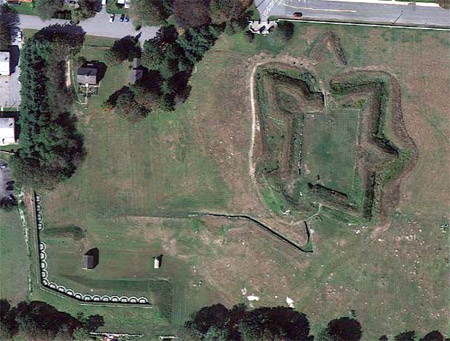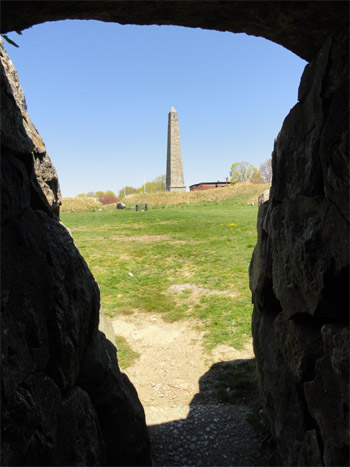 |
Fort Griswold
Groton, Connecticut, USA
|
|
 |
Constructed: 1775 - 1778
Used by: United States of America
Conflict in which it participated:
US Revolutionary War
|
The cities of Groton and New London, Connecticut, face each other across the Thames River at a natural deepwater harbor. At the start of the US Revolutionary War (1775-1783), this harbor was Connecticut's military naval base, merrily sending privateers out to commit 100% legal (at least as far as Congress was concerned) acts of piracy against British shipping.
|
 |
|
|
Armed with a Letter of Marque (the document that made it legal for armed civilians to attack British ships on the high seas), Connecticut seamen sailed up and down the east coast, collecting various useful items from the Royal Navy, which they then deposited in the warehouses of New London. The Thames' proximity to Long Island Sound, a busy place indeed during the Revolutionary War, led to the reasonable assumption was that King George III (1738-1820) would take steps to deal with these Grotonians in a decisive manner. Fortunately the decision was made to fortify.
|
Fort Griswold's Covered Way, an impressive trench through which the fort's defenders could scramble from the fort to the separated River Battery while under fire |
 |
Well. This fortification urge didn't wind up doing the cause of American independence a whole heap of good during the war, but it's fortunate for we the starfort enthusiasts today...because even though both Fort Griswold and Fort Trumbull across the river in New London are relatively tiny little things, they're both absolutely gorgeous. Fort Trumbull is in much better shape today, all white and pointy and shiny, but Fort Griswold possesses a kind of hairy charm all its own. Fort Griswold was named for Matthew Griswold (1714-1799), who served as both Chief Justice of Connecticut's Superior Court and Deputy Governor from 1769 to 1784. Griswold would go on to serve a term as Governor from 1784 to 1786. |
|
We find ourselves coming back once again to Benedict Arnold (1741-1801), the Revolutionary War traitor that American schoolchildren are still expected to hate most vociferously. As depicted in Kenneth Roberts' (1885-1987) excellent novels Arundel and Rabble in Arms, Arnold was an energetic, effective and inspiring leader, indeed one of very few such officers in American service.
Many of Arnold's impressive accomplishments were claimed by others, and Congress never stopped giving him a hard time over endless petty nonsense. The man had finally had enough in 1799, and switched sides, an act for which I felt a certain amount of sympathy, until I visited Fort Griswold and could better witness the result of his treachery. You're dead to me, Benedict.
There may well have been a British attack on New London and Groton in 1781 without the participation of the aforementioned Benedict, but as he had spent time at both Fort Trumbull and Fort Griswold he was able to provide both detailed information regarding the manpower and armament the British could expect to encounter and draw extremely detailed maps of both forts, which no doubt aided the British greatly in the near-complete decimation of the garrisons at both forts.
|
Arnold, who had been seeking an independent command for the King ever since switching sides, was put in command of an expedition to punish New London on September 2, 1781. A fleet of 32 Royal Navy ships was spotted by troops at Fort Griswold on the morning of September 6, and they duly fired two guns at fixed intervals, the signal to local militia that the fort was under imminent attack. Familiar with this code (thanks, Benedict!), one of the British ships added one more gun, changing the message to "never mind, militia!"
Arnold landed with 900 troops on the west bank of the Thames, where they
|
 |
 Fort Griswold as it lies. At the lower left is the River Battery. Fort Griswold as it lies. At the lower left is the River Battery. |
|
advanced on Fort Trumbull. All of 24 men were currently garrisoning that fort, and after firing a single volley and spiking their guns, they scampered into boats and escaped to the other side of the river. Having secured New London, the Redcoats set about destroying a great deal of the city, including all shipping, docks, several storehouses and private residences and anything that could even slightly be construed as military.
Snickering fiendishly and rubbing his hands together in a sinister fashion over his success, Arnold ordered the 850 British troops that had landed on the eastern bank of the Thames to attack Fort Griswold immediately if not sooner. Two summons for surrender were sent to the fort as the British moved into position, but Fort Griswold's commander, Colonel William Ledyard (1738-1781), thumped his chest and bellowed, we
shall not surrender, let the consequences be what they may! Oh, there were consequences. |
Groton Monument and Fort Griswold by John Warner Barber (1798-1885): How it looked in 1836 |
 |
The inevitable British attack did manage to overpower the defenders of Fort Griswold, but at the price of the attacking division's two senior officers and 178 other casualties. It's assumed that the death of the officers enraged the Redcoats...as though the Americans defending their fort from attack was somehow unfair?
For whatever infuriating reason, a Major Bromfeld, now the ranking British officer, entered the fort to receive the surrender of Col. Ledyard, who handed Bromfeld his sword in the internationally understood gesture of formal surrender. Which Bromfeld than plunged into Ledyard's chest, sparking a slaughter of the now unarmed fort's garrison. |
|
Maybe. Though Bromfeld killing Ledyard in this wanton manner seems to be the general consensus now, exactly what happened at the surrender of Fort Griswold is a bit murky. Contemporary accounts of this event have none other than Benedict Arnold murdering Col. Ledyard at Fort Griswold and ordering the needless slaughter of the fort's helpless garrison. However it actually went down, the point of war is to kill the other guys, but the outcome of the Battle of Groton Heights was pretty darned uncalled for. |
85 Americans were killed in the post-surrender massacre, with another 35 wounded. 35 prisoners were marched off to captivity, and charges were set to blow Fort Griswold's powder magazine...an attempt that was foiled by a Major Peters, who waited for the British to sail away and then applied water to the fuse they had lit.
The British force attacking New London and Groton was a raiding party, not numerous enough to occupy anything. The wicked Arnold-commanded scourge left, but had SPREAD DESOLATION AND WOE THROUGHOUT THIS REGION, as is inscribed on the Groton Monument.
Fort Griswold was lightly manned during the War of 1812 (1812-1814), but the Royal Navy contented itself with blockading the Thames and never attacked inland. In 1818 the fort had 12 guns, and during the US Civil War (1861-1865) these guns were upgraded with four 8" smoothbore Rodman Guns...but again, nobody showed up to be fired at.
By 1903 Fort Griswold had a 14cm rifled gun in addition to its Rodman Guns, plus seven unmounted cannon, which aren't much use to anybody lying on the ground like that, now are they. Around all of these guns the tall grass waved merrily in the breeze, as
|
 |
 The Groton Monument (built from 1826 to 1830 to honor those who fell at the Battle of Groton Heights) through Fort Griswold's sally-port The Groton Monument (built from 1826 to 1830 to honor those who fell at the Battle of Groton Heights) through Fort Griswold's sally-port |
|
the fort had not been in use for decades. On November 17, 1903, the US Army officially handed Fort Griswold over to the state of Connecticut. Today, Fort Griswold State Park includes the fort, the River Battery and the Groton Monument. I visited this park in May of 2013 and was impressed with the height of Groton Heights...those Redcoats must've been panting by the time they got to the fort, because I certainly was, and I was not carrying a 10.5-pound Brown Bess musket! Won't you visit Fort Griswold in Starforts.com's Starforts I've Visited section? |
|
|
|
|
|
 |




